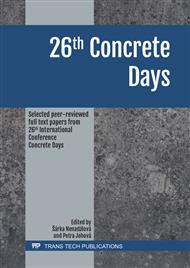p.228
p.234
p.240
p.246
p.252
p.261
p.267
p.272
p.281
3D Printing of Concrete Structures Modelled by FEM
Abstract:
This paper presents the possibility to utilize the 3D printing technology in civil engineering field specifically for concrete structures. Since this technology is booming last years and spreads in different fields of industry, the tools to analyse structures in such a way is important. Many research groups worldwide try to develop cement-based material suitable for 3D printing so that it might be used for civil engineering structures. Moreover, this technology brings necessity to check the safety of the structure at early ages of concrete. Therefore, the modelling and simulation of the digitally printed concrete structure would be of great help for such effort. The software tool that enables simulation of digitally printed concrete structure using a nonlinear FEM analysis is presented. ATENA is well established tool for such analyses of civil engineering structures made of concrete. The new module for digital printing simulation is developed as an additional feature of ATENA software. The 3D extrusion technology is supported. The paper describes the whole procedure how to model and analyse such structures and stress out all the differences compared to analyses of structures produced by traditional manner. The structure itself is modelled as usual in FE software, whereby based on velocity of printing head the time of printing, i.e. production of each element is calculated. It is later used to activate the elements during analysis and it also influence the material behaviour, such as shrinkage, strength etc.
Info:
Periodical:
Pages:
261-266
Citation:
Online since:
August 2020
Authors:
Price:
Сopyright:
© 2020 Trans Tech Publications Ltd. All Rights Reserved
Share:
Citation:


